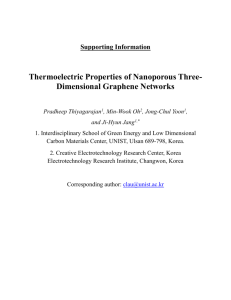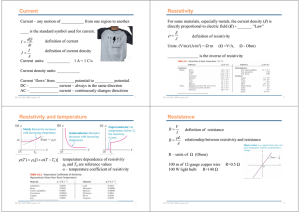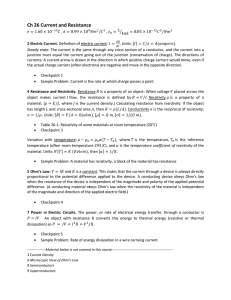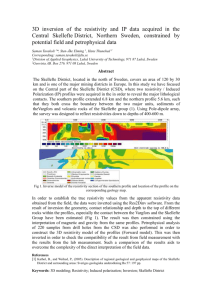The use of multi-electrode resistivity imaging in gravel prospecting
advertisement
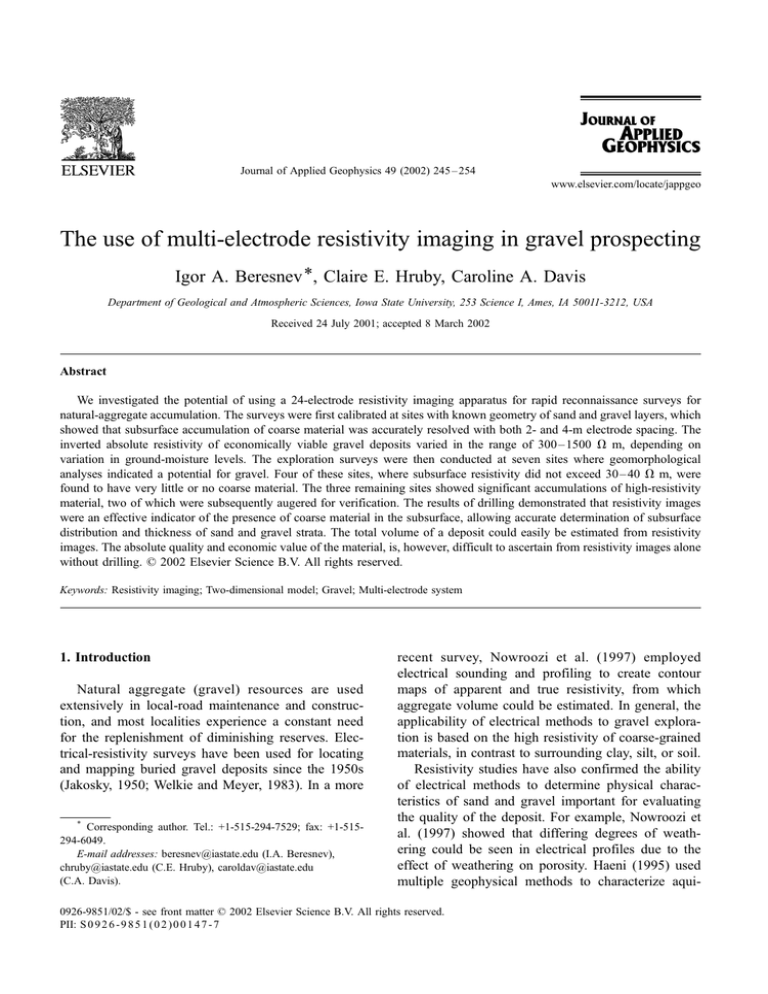
Journal of Applied Geophysics 49 (2002) 245 – 254 www.elsevier.com/locate/jappgeo The use of multi-electrode resistivity imaging in gravel prospecting Igor A. Beresnev *, Claire E. Hruby, Caroline A. Davis Department of Geological and Atmospheric Sciences, Iowa State University, 253 Science I, Ames, IA 50011-3212, USA Received 24 July 2001; accepted 8 March 2002 Abstract We investigated the potential of using a 24-electrode resistivity imaging apparatus for rapid reconnaissance surveys for natural-aggregate accumulation. The surveys were first calibrated at sites with known geometry of sand and gravel layers, which showed that subsurface accumulation of coarse material was accurately resolved with both 2- and 4-m electrode spacing. The inverted absolute resistivity of economically viable gravel deposits varied in the range of 300 – 1500 V m, depending on variation in ground-moisture levels. The exploration surveys were then conducted at seven sites where geomorphological analyses indicated a potential for gravel. Four of these sites, where subsurface resistivity did not exceed 30 – 40 V m, were found to have very little or no coarse material. The three remaining sites showed significant accumulations of high-resistivity material, two of which were subsequently augered for verification. The results of drilling demonstrated that resistivity images were an effective indicator of the presence of coarse material in the subsurface, allowing accurate determination of subsurface distribution and thickness of sand and gravel strata. The total volume of a deposit could easily be estimated from resistivity images. The absolute quality and economic value of the material, is, however, difficult to ascertain from resistivity images alone without drilling. D 2002 Elsevier Science B.V. All rights reserved. Keywords: Resistivity imaging; Two-dimensional model; Gravel; Multi-electrode system 1. Introduction Natural aggregate (gravel) resources are used extensively in local-road maintenance and construction, and most localities experience a constant need for the replenishment of diminishing reserves. Electrical-resistivity surveys have been used for locating and mapping buried gravel deposits since the 1950s (Jakosky, 1950; Welkie and Meyer, 1983). In a more * Corresponding author. Tel.: +1-515-294-7529; fax: +1-515294-6049. E-mail addresses: beresnev@iastate.edu (I.A. Beresnev), chruby@iastate.edu (C.E. Hruby), caroldav@iastate.edu (C.A. Davis). recent survey, Nowroozi et al. (1997) employed electrical sounding and profiling to create contour maps of apparent and true resistivity, from which aggregate volume could be estimated. In general, the applicability of electrical methods to gravel exploration is based on the high resistivity of coarse-grained materials, in contrast to surrounding clay, silt, or soil. Resistivity studies have also confirmed the ability of electrical methods to determine physical characteristics of sand and gravel important for evaluating the quality of the deposit. For example, Nowroozi et al. (1997) showed that differing degrees of weathering could be seen in electrical profiles due to the effect of weathering on porosity. Haeni (1995) used multiple geophysical methods to characterize aqui- 0926-9851/02/$ - see front matter D 2002 Elsevier Science B.V. All rights reserved. PII: S 0 9 2 6 - 9 8 5 1 ( 0 2 ) 0 0 1 4 7 - 7 246 I.A. Beresnev et al. / Journal of Applied Geophysics 49 (2002) 245–254 fers in the northeastern United States and concluded that the bulk resistivity of an aquifer was generally representative of the aquifer’s grain-size characteristics. The traditional resistivity surveys use a set of four in-line electrodes in an expanding-spread (sounding) or constant-spread (profiling) modifications. In the popular Schlumberger and Wenner geometries, the two end (current) electrodes inject electric current, and the two middle (potential) electrodes measure the potential difference at the surface (Burger, 1992). The shortcoming of these techniques is that significant time is necessary to collect data to cover a certain depth range, since a complete procedure involves multiple reinstallation of the electrodes along the profile. The quantitative interpretation of such data for a single sounding is usually limited to simple horizontal-layered (one-dimensional) geometries. A recent technological breakthrough has been related to the appearance of multi-electrode imaging systems. The simultaneous use of a large number of in-line electrodes allows the imaging systems to combine electrical sounding and profiling in one field set-up without the need for redeploying the electrodes, providing nearly instant depth coverage. The line of electrodes is quickly scanned from one end to the other by an automated communication system, which collects readings from all possible four-electrode combinations. For example, a 24-electrode system provides 121 Wenner – Schlumberger readings in about 15 min (see system description below). The combined apparent-resistivity data set can then be directly imported into a computer-inversion program that generates a detailed two-dimensional (2D) trueresistivity section. The multi-electrode systems expand the capabilities of the traditional electrical method, combining speedy data collection with the possibility of achieving 2D images of the subsurface. In this paper, we explore the possibility of using a 24-electrode, automated DC (direct-current) imaging equipment for rapid reconnaissance surveys for aggregate deposits. We use the ResiStar RS-100M imaging system with the ME-100 multi-electrode cable, manufactured by Geofyzika. We calibrate the method at an excavated site with the known gravel-layer geometry, and then apply it to surveying the sites of suspected but unknown potential. The electrical-survey findings are verified by drilling. 2. Geologic background and site selection The fieldwork was performed in Story County, central Iowa. The project was initiated due to a rapid depletion of available gravel reserves, creating a need for finding new prospective sites. Electrical-resistivity methods were not tested for this purpose in the county before. The main source of natural aggregate in Story County is glacio-fluvial deposits associated with the Des Moines Lobe of the Laurentide Ice Sheet (Bettis et al., 1996). The most common of these deposits is outwash concentrated in former meltwater channels, which occur as terraces or point bars. These deposits are generally found in close proximity to modern streams that have exploited these preexisting channels. Terraces occur within the margins of the channels, generally at intermediate elevations between the Quaternary flood plain and the till uplands. Less commonly, ice contact deposits including kames, eskers, and crevasse fillings are also found to be potential sources of coarse material. These deposits occur as isolated topographic highs and may consist of a variety of mixed or sorted materials including sand, gravel, till, and, occasionally, clay. It follows that most sites with the potential for aggregate accumulation have clear topographic expression. The initial sites for the electrical surveys were selected by Deborah Quade, a research geologist with the Iowa Geological Survey Bureau, based on the analysis of topographic and soil maps and knowledge of glacial landforms. Resistivity imaging was then used to identify sites with substantial coarse-grained deposits in the subsurface. In addition to the two calibration sites, we surveyed a total of seven suspected sites, with one to seven resistivity lines run at each of them depending on the size of the site and the potential for gravel determined by initial data. The (true) resistivity of subsurface material generally varied in the range of 10 –1200 V m. 3. Method of data collection and inversion All apparent-resistivity data were collected using the line of 24 electrodes spaced at 4 m, to give a total length of the line of 92 m. Multi-electrode data collection was done in the Wenner – Schlumberger I.A. Beresnev et al. / Journal of Applied Geophysics 49 (2002) 245–254 modification. For comparison of the effect of spacing between the electrodes on the quality and resolution of images, we collected data along the same line at one of the calibration sites using both 2- and 4-m spacings. With the 2-m spacing, we used 48 electrodes instead 247 of 24 to retain the same length of the line. We found that the quality of images of the known gravel layer did not degrade to any degree of practical significance as we increased the spacing by a factor of 2 (see comparison of Figs. 1a and 2 below), whereas the Fig. 1. Calibration of multi-electrode survey at the excavated gravel pit. (a, b) Inverted resistivity cross-section along the northern embankment of the lake and the geology exposed in the embankment, respectively. Horizontal distance is in meters. The two sections correlate well; the gravel lens exposed behind the person is clearly seen in the resistivity section. (c) Inverted resistivity section along the perpendicular (western) edge of the pit, where no gravel was found by excavation. The electrical section shows no coarse (high-resistivity) material. 248 I.A. Beresnev et al. / Journal of Applied Geophysics 49 (2002) 245–254 data-collection time increases with spacing nearly exponentially. Based on this comparison, it was decided that the surveys be conducted at the 4-m spacing. The multi-electrode apparent-resistivity readings are written on the disk file and transferred to an external PC. The files are then inverted using the commercial interpretation software RES2DINV (Loke, 1997, 1999). The program uses a nonlinear leastsquares optimization technique to obtain the inversion of apparent resistivities (Griffiths and Barker, 1993; Loke and Barker, 1996). The total time to obtain a complete inversion of one 24-electrode file does not exceed a few seconds on a Pentium III processor. The inversion program allows control of the accuracy of final inverted sections; this accuracy is defined as the root-mean-square (RMS) difference between the observed and calculated pseudosections. The inversion stops when this difference decreases below a userdefined tolerance level, given in percent. All the subsequent inverted sections have the RMS error of less than 5%, typically 1– 2%. An example comparison of an observed and a calculated pseudosections is given in Fig. 3 below. 4. Method calibration To obtain the notion of the accuracy of the method and its ability to locate sand and gravel accumulations, the method was first calibrated at two independent sites. The first calibration site was the existing gravel pit, where the attitude and thickness of a pay gravel layer was well established from several years of excavation (Beach Pit, Marshall County, Iowa). The lens of the gravel material is clearly exposed in the lake embankment at the northern edge of the pit (Fig. 1b), allowing direct comparison of resistivity cross-sections with the realistic material geometry. The second calibration site was not excavated, but its significant gravel accumulation was confirmed by a series of boreholes (the Eggers’ property, Story County). Fig. 1 presents the calibration results at the Beach Pit. The same logarithmic color scale is used to display the 2D resistivity cross-sections in V m in Fig. 1a and c; the maximum penetration depth of the surveys is approximately 15 m near the center of the lines. Fig. 1a shows the section running along the northern side of the pit where the coarse material is exposed in the embankment. It was obtained with the electrode spacing of 4 m common to all surveys. Fig. 1a and b are juxtaposed to facilitate comparison. The gravel lens is clearly seen in the resistivity section as the ‘‘spot’’ of high resistivity, showing large contrast with surrounding material. The depth to the top of the lens, inferred from the resistivity section, is about 3 m, which coincides with the depth seen in Fig. 1b. Note that only the upper part of the lens is exposed in the embankment (Fig. 1b), while the resistivity section shows it extending to the depth of about 10 m, where it is underlain by fine-grained, low-resistivity material. According to the electrical section, the gravel layer dips to the east (right side of Fig. 1a) and has a total thickness of about 7 m, which is also known from excavation. The low-resistivity material above the gravel layer in Fig. 1a is the man-made overburden created by relocation of soil during excavation. The transition from gravel to overburden is also clearly seen in the photograph in Fig. 1b. As stated above, we additionally tested this calibration line with a 2-m spacing between electrodes, to check on the effect of spacing on the quality of images. Fig. 2 presents the same section as in Fig. 1a but obtained with the 2-m spacing (its depth scale is slightly different, being controlled by RES2DINV). The comparison of the two images shows that they are nearly identical for the purposes of the surveys, in that Fig. 2. The resistivity cross-section along the same line as in Fig. 1a but obtained with 2-m spacing between electrodes. I.A. Beresnev et al. / Journal of Applied Geophysics 49 (2002) 245–254 249 Fig. 3. The observed and calculated pseudosections for the profile from Fig. 2. the important details of the geometry of the gravel deposit are well revealed with the 4-m spacing. Fig. 3 illustrates the accuracy of inversion by showing the comparison between the observed and calculated pseudosections for the profile in Fig. 2. There are no discernible differences between the sections; the RMS difference is 1.5%. To check on the seasonal variation of inverted resistivity images for the same geological profile, we conducted electrical surveys at the above calibration line in late November 2000 and early April 2001. The section in Fig. 2 is from the April 2001 survey; it shows the resistivity of coarse material approaching 300 V m. Fig. 4 shows the resistivity cross-section obtained using the same 2-m electrode spacing in November 2000 (the length of the line was slightly shorter, 78 m). It is important to note that the two seasons had distinct differences in ground-moisture content. The summer and fall of 2000 were extremely dry, approaching drought-like conditions. In contrast, the spring of 2001 was extremely wet. These observations were reinforced by the rise in the water level in the lake by approximately 3 m in spring. Fig. 4 shows that the resistivity of the same coarse material in the November 2000 survey was significantly higher, approaching approximately 1500 V m. However, Figs. 2 and 4 show that the images of the gravel layer remained virtually unchanged, despite the fact that the absolute values of resistivity changed dramatically. It follows that the significant moisture content in the ground in spring 2001 lowered the absolute resistivity values, although it did not change the contrast between the gravel layer and the surrounding lower-resistance material. This is an important observation, indicating that the resistivity contrast was primarily controlled by the lithology and grain-size characteristics, not the degree of water saturation, if the latter is similar throughout the section. This is Fig. 4. The resistivity cross-section along the same line and with the same spacing as in Fig. 2 but obtained during the dry season. 250 I.A. Beresnev et al. / Journal of Applied Geophysics 49 (2002) 245–254 consistent with similar conclusions reported by Haeni (1995). Note that the water table (assumed to coincide with the level of the lake) rose from about 2 m below the top of the gravel lens (Fig. 1b) in November 2000 to about 1 m above it in April 2001. However, the comparison of Figs. 2 and 4 does not distinctly reveal the changing water level; the qualitative features of the resistivity sections remain the same. Although somewhat surprising, this observation is consistent with the above conclusion about the predominant effect of lithology on the observed resistivity contrast at the surveyed location. Finally, Fig. 1c presents the resistivity cross-section along the perpendicular (western) edge of the pit, where the excavation reached the end of the gravel deposit. The electrical section confirms the absence of coarse material below the ground, with resistivities not exceeding 60 V m. The exception is the northern end of the line (right end in Fig. 1c), where the line comes close to the transect of Fig. 1a and thus begins to show the proximity of the same gravel layer. At the second calibration site (the Eggers’ property), we were given the opportunity to compare our resistivity cross-sections with drill-log data. The lithology suggested by resistivity interpretation correlated well with the observed subsurface materials. The gravel layer was distinctly seen in the cross-sections as the material with high resistivity (up to 2000 V m), in contrast with overlying soil and underlying limestone (Beresnev et al., 2001). It follows from these observations that the resistivity of economically viable coarse material can be expected to lie in the range of 300 to 1500 V m, depending on moisture conditions. The resistivity of the wet sand and gravel is on the lower end of this interval; however, it still exhibits sufficient contrast with surrounding deposits. The drier coarse material is on the higher end of the range, which is consistent with the normally assumed values (e.g., Burger, 1992, p. 295). 5. Survey results Upon establishing criteria for recognizing potential aggregate deposits on the inverted resistivity sections, we surveyed the seven selected new-exploration sites. The surveys took place in the spring of 2001, when, as indicated above, significant amounts of moisture were present in the ground reducing overall values of bulk resistivity. Based on the resistivity readings, four of the seven sites, where bulk resistivity did not exceed 30 –40 V m, were found to have very little or no coarse material. At one of these sites, the results of drilling confirmed the findings based on resistivity values. The remaining three sites exhibited high resistivity and were recommended for drilling, which was conducted at two of them (Sites 1 and 4 using the adopted numbering scheme). In the following, we show the results of the verification of resistivity findings by drilling. 5.1. Site 4 A total of seven lines were run at Site 4. Five of them showed significant accumulation of coarse material under the surface. The combined resistivity section of two of these latter lines is presented in Fig. 5. The layer of coarse material dipping from right to left is clearly identified on this section, with two ‘‘lenses’’ of high resistivity seen near the right end. Drilling was Fig. 5. Combined resistivity cross-section at Site 4, showing a layer of coarse (high-resistivity) material dipping to the left. Vertical lines with numbers indicate the locations of the two boreholes. I.A. Beresnev et al. / Journal of Applied Geophysics 49 (2002) 245–254 251 rial and its total thickness, as revealed by the electrical survey. However, the material itself turned out to be primarily composed of the chunks of soft, weathered sandstone, not suitable for use on roads. Additional drilling at Site 4 revealed loamy deposits underlain by clays where resistivity lines found only low-resistance materials. 5.2. Site 1 Fig. 6. Locations of resistivity lines and drillholes (numbered circles) at Site 1 with significant gravel potential. The symbols are superimposed on a scanned, blown-up topographic map, showing that the lines were run across a gentle hill. conducted at these two suggested locations; the boreholes are identified by the vertical lines and their numbers (2 and 4) assigned during the surveys. Technically, no cores were extracted during the exploration drilling; the sites were augered to the necessary depth, and a rough estimate of quality was determined for the material that was brought to the surface. Both boreholes confirmed the presence of the coarse mate- Significant accumulations of high-resistivity deposits were also found at Site 1, indicating the promising potential for sand and gravel. The layout of the five resistivity lines conducted at this site is shown in Fig. 6, where circles indicate the boreholes. Local topography, illustrated in Fig. 6, indicates that this site is probably a kame. Kames are created when meltwater transports debris to the base of a glacier through a hole in the ice; they are expressed as clear topographic highs. Resistivity cross-sections along lines C and E are shown in Fig. 7, with the locations of the boreholes also marked. The boreholes were normally drilled until clay material was brought to the surface, indicating the total thickness of a gravelly deposit. Fig. 7 gives an idea of possible thickness of sand and gravel, inferred from the resistivity distribution, while Fig. 8 presents the approximate stratigraphic columns con- Fig. 7. Resistivity cross-sections along lines C and E at Site 1. Boreholes correspond to those shown in Fig. 6. 252 I.A. Beresnev et al. / Journal of Applied Geophysics 49 (2002) 245–254 structed from the results of augering. Caution must be exercised in reading the exact values of depth from the columns in Fig. 8. As mentioned above, the depth associated with the material brought to the surface was based on the current depth of auger penetration. This method is not precise, and we estimate that the error could be as much as half a meter. The depths shown in Fig. 8 should thus be considered approximate only. A comparison of the resistivity sections in Fig. 7 and logs in Fig. 8 shows that the thickness and the depth of the sand and gravel layer, identified by electrical survey, is in good agreement with the results of drilling. For example, sand and gravel was realistically encountered at all boreholes at the depth intervals marked by high resistivity. Borehole 1, which could be characterized as having the least potential based on the resistivity readings, is confirmed to have only a small fraction of gravel (Fig. 8). Borehole 3, showing an intersection with a low-resistivity layer at the depth of about 4 m (Fig. 7), revealed a clay horizon at that depth (Fig. 8). The average depth of 7 to 9 m of the gravelly layer, underlain by clay, inferred from the resistivity sections, is also confirmed by drilling. More importantly, the highest-resistivity Fig. 8. Borehole logs at Site 1. I.A. Beresnev et al. / Journal of Applied Geophysics 49 (2002) 245–254 ‘‘spots’’ transected by boreholes 4 and 5 (Fig. 7) turned out to contain the thickest sand and gravel accumulation as well (Fig. 8). The gravel quality at Site 1 was considerably better than at Site 4 due to a significant fraction of hard quartzite cobbles. From the image in Fig. 7, a total volume of the sand and gravel deposit could easily be estimated. Fig. 9 presents the lithological interpretation of the resistivity profiles of Fig. 7, based on the results of drilling. It shows the total volumetric extent of the sand and gravel layer and suggests the presence of inclusions of loamy and clayey material. The nature of the bottommost, lowest-resistivity layer in Fig. 7 cannot be ascertained with confidence. The uncertainty of inversion increases to the bottom center of the profiles (Loke, 1999), where this layer occurs. It could indicate the water table; however, since no borehole reached this depth and due to above uncertainty pattern, the bottom of the section in Fig. 9 remained undefined. 253 Figs. 7 and 9 show that the resistivity profiles provide key information for assessing the general economic value of the suspected gravel accumulation. 6. Conclusions We conducted 2D resistivity surveys using a 24electrode imaging system. The results of the surveys indicate that the multi-electrode imaging is a useful tool in rapid evaluation of the potential for aggregate accumulation at sites that can be identified based on landform expression. Calibration at sites with known geometry of gravel layers showed that the resistivity of aggregate material could lie within the range of 300 to 1500 V m, depending on seasonal variation in ground-moisture levels. A conclusion from our calibration lines at the existing gravel pit is that, while the absolute resistivity of sand and gravel may vary significantly from season to season, its contrast with Fig. 9. Geological interpretation of subsurface structure based on combined information from resistivity profiles (Fig. 7) and drilling (Fig. 8). 254 I.A. Beresnev et al. / Journal of Applied Geophysics 49 (2002) 245–254 surrounding fine-grained material remains stable so that the gravel can still be easily identified. We also concluded that, for the investigated targets, the system with 24 electrodes spaced at 4 m provides a spatial resolution seemingly as good as that with 48 electrodes spaced at 2 m. The use of the 48-electrode system, which requires significantly longer time to collect readings, is not justified. The method was applied to surveying seven sites identified as having potential for gravel from geomorphological analyses. Based on the inverted absolute resistivity values, we found that four of these sites had very little or no coarse material, which was confirmed at one site by a test borehole. Their subsurface resistivity did not exceed 30 – 40 V m. The three remaining sites showed high resistivity values. Two of them were drilled; the results of drilling confirmed both the presence of coarse material, its thickness, and geometry inferred from the resistivity sections. Electrical imaging thus provides reliable information for site characterization in terms of aggregate potential, supplying information on the spatial distribution of the deposit from which the volume can be easily estimated. Drilling at one of these sites indicated, though, that the coarse material there consisted primarily of chunks of soft sandstone, not suitable for road maintenance. The material at the other site was of good quality. These results indicate that, although resistivity imaging is a good indicator of the presence of coarse material, the absolute quality and economic value of that material is difficult to ascertain without drilling. Acknowledgements This study was supported by Story County (Iowa) Board of Supervisors through the Office of County Engineer. We are indebted to Harold Jensen, whose interest and effort initiated this work. William Simpkins drew our attention to the possibility of using resistivity measurements for gravel exploration in the county. Deborah Quade (Iowa Geological Survey Bureau) identified the initial sites for electrical surveys. Drilling was performed by Becker Gravel. We are grateful to Merle Eggers for the permission to run several calibration lines on his property, and to numerous other property owners who allowed us to conduct exploration surveys. Matthew Graesch helped to carry out field work in November 2000. We appreciate constructive comments by Editor N. Christensen and two anonymous reviewers. References Beresnev, I.A., Hruby, C., Davis, C., 2001. Geophysical imaging for detection of aggregate accumulation. Report submitted to the County Engineer’s Office, Story County, Iowa. Bettis, E.A., Quade, D.J., Kemmis, T.J., 1996. Hogs, Bogs, and Logs: Quaternary Deposits and Environmental Geology of the Des Moines Lobe. Geol. Surv. Bur. Guideb., vol. 18. Iowa City, IA. Burger, H.R., 1992. Exploration Geophysics of the Shallow Subsurface. Prentice Hall, New Jersey, 489 pp. Griffiths, D.H., Barker, R.D., 1993. Two-dimensional resistivity imaging and modelling in areas of complex geology. Journal of Applied Geophysics 29, 211 – 226. Haeni, F.P., 1995. Application of surface-geophysical methods to investigations of sand and gravel aquifers in the glaciated northeastern United States. Regional Aquifer-System Analysis— Northeast Glacial Valleys. U.S. Geol. Surv. Prof. Pap., pp. A1 – A70. Jakosky, J.J., 1950. Exploration Geophysics, 2nd edn. Trija Publishers, Los Angeles, 1195 pp. Loke, M.H., 1997. Electrical imaging surveys for environmental and engineering studies. A practical guide to 2-D and 3-D surveys, Penang, Malaysia, 57 pp. Loke, M.H., 1999. RES2DINV—rapid 2-D resistivity and IP inversion using the least-squares method. Software manual, 81 pp. Loke, M.H., Barker, R.D., 1996. Rapid least-squares inversion of apparent resistivity pseudosections by a quasi-Newton method. Geophysical Prospecting 44, 131 – 152. Nowroozi, A.A., Whittecar, G.R., Daniel, J.C., 1997. Estimating the yield of crushable stone in an alluvial fan deposit by electrical resistivity methods near Stuart Draft, Virginia. Journal of Applied Geophysics 38, 25 – 40. Welkie, C.J., Meyer, R.P., 1983. Geophysical evidence that the Haeger Till member underlies southern western Lake Michigan. Geoscience Wisconsin 8, 45 – 48.


